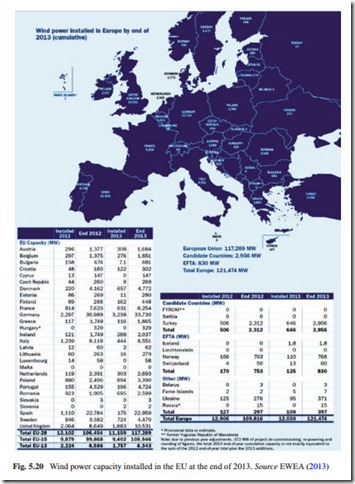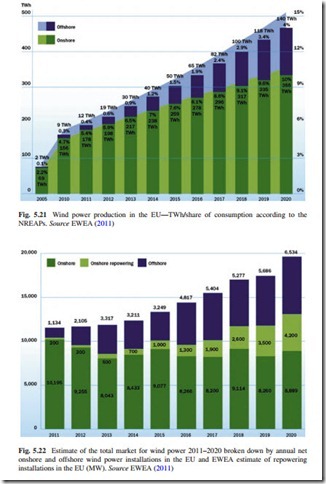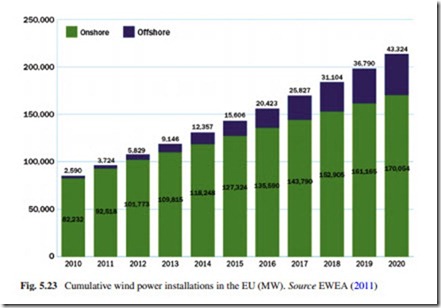Austria
Although Austria is a landlocked country with a distinguished hilly topography, meteorological preconditions permit the utilization of wind power for the generation of electricity. First calculations on the basis of wind measuring data assessed at the meteorological stations in the early 1980s rendered the surprising result of annually approximately 6,600–10,000 GWh of technically exploitable wind energy potential in the country. Austria ranked as the world’s 17th largest producer of wind power with an installed capacity of 995 MW in 2008, behind Ireland and ahead of Greece. In 2012, Austria reached a wind-installed capacity of 1,378 MW; this represents an increase of 38.5 % with respect to 2008. The wind power capacity installed in the country represents in 2012 a total of 6.13 % of the total energy capacity installed in the country and 8.17 % of the total renewables capacity installed in that year.
Austria occupies the place number 43 at world level according to the total wind power capacity installed (0.48 % of the world total) and the place number 16 at regional level (1.26 % of the regional total). The 10-year compound annual growth rate was 12.75 %, and the country reached a growth in 9 out of the last 10-year period considered.
Back in the 1980s, there were huge private wind measurements and experiments with smaller wind plants. In 1994, initiated by Councilor Waltner, 110-kW wind turbine was set up in St. Pölten. Another wind turbine was put into operation six months later in Zistersdorf. In 1995, the first wind turbine was built with civic participation in Michelbach. In January 1996, the first turbine of the type E-40 with 500 kW was placed in Eberschwang. Not only the absolute largest wind turbines
were placed there, but with two turbines the first wind farm was also established. In the course of 1996, no signs of new funding arrangements had emerged. A total of 36 wind turbines with 12 MW and an annual total of 18 million kW of work hours had been set up. After 1996, there were, only in exceptional cases, economic condi- tions for individual projects, including the wind park in Zurndorf with six turbines.
The pressure of individual countries and the idea that desired objectives could be reached nationwide cheaper than by any nation-state alone resulted in negotia- tions between federal and state governments to a new nationwide Green Electricity Act 2002 in spring 2002. Wind turbines with a capacity of a total of 276 MW were built in 2003. The wind farm output tripled from 139 MW (end 2002) to 415 MW (end 2003) within a year.
According to EWEA 2011, Austria intends to meet its overall 34 % renewables target largely through the increase of renewables in the energy mix. As such, Austria has set itself the highest target of electricity from renewables of any EU mem- ber state: 71 % in 2020. Overall, the Austrian NREAP (2010) expects to slightly exceed its 2020 target. According to the plan, with a cumulative installed capacity of 2.6 GW, wind should represent less than 10 % of the electricity from renewables target, covering just below 7 % of total electricity consumption in 2020. This is sig- nificantly below EWEA’s 2009 scenario, which puts Austria’s 2020 wind potential between 3.5 and 4 GW, meeting between 9.5 and 11 % of electricity consumption.
After several years of stagnation in the Austrian wind power market, the action plan foresees from 2012 onward an increase in net annual capacity by 10–20 MW per year, reaching 107 MW annually in 2020.
From Table 5.10, the following can be stated: Austria needs to install 894 MW new wind capacity during the period 2013–2020 in order to reach the target adopted by the government and included in the NREAP.
The wind power capacity installed in the country during the period 2000–2013 increased 21.9-fold (from 77 MM in 2000 to 1,684 MW in 2013). In the past four years, the total wind power-installed capacity increased 66 %, and this trend is expected to continue at least until 2020.
According to Zervos and Kjaer (2008), the total available budget for the use of renewable energy source for the generation of electricity in Austria has been set at €17 million for new installations up to 2011. This yearly budget is pre- allocated among different types of renewable energy source (30 % to biomass, 30 % to biogas, 30 % to wind, and 10 % to solar PV and the other remaining renewables).
The evolution of the generation of electricity in Austria using wind energy during the period 2008–2012 is shown in Fig. 5.24.
From Fig. 5.24, the following can be stated: The generation of electricity in Austria during the period 2008–2012 using wind energy increased 19.3 %. It is expected that the generation of electricity using this type of energy source in Austria will continue increasing during the coming years, in order to achieve the target approved by the government on the role of wind power in the country energy mix.




